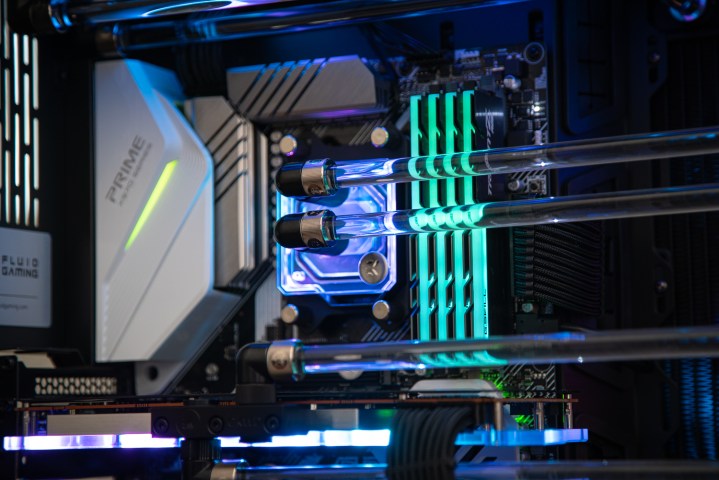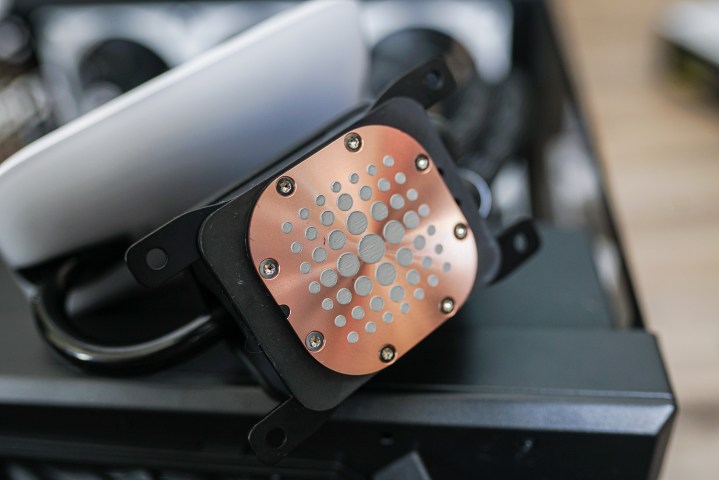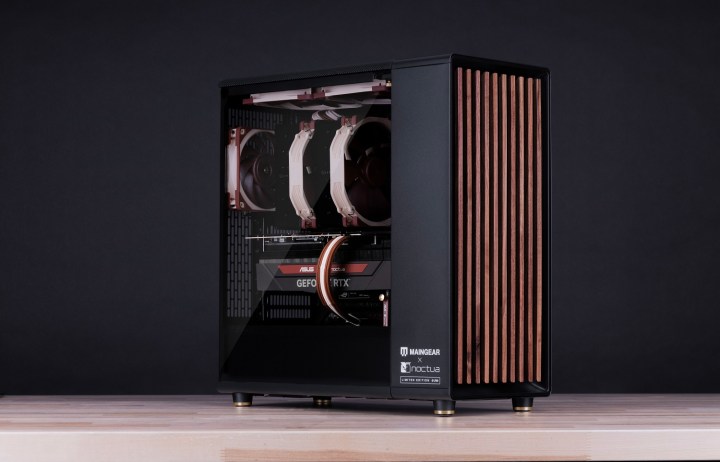
I made a decision about 13 years ago — air cooling isn’t for me. I picked up AMD’s FX-8150, assuming I could use the bundled cooler without too many issues. I was wrong. It was obnoxiously loud, even when sitting on the Windows desktop. The day after building my PC, I went to Tiger Direct (a physical store, when those still existed), picked up a Corsair H100, and I haven’t looked back since. Until now.
After dozens of builds and years of using all-in-one (AIO) liquid coolers, I’m back to using an air cooler. The reason why is simple. I reconfigured my PC inside the petite Fractal Terra, which only has enough room for a low-profile air cooler with my graphics card. The transition wasn’t as extreme as I thought it would be, though, and after digging a bit into the differences between liquid and air cooling, I’m shocked I didn’t make the transition earlier.
A heating and cooling primer

Pull out your notebooks — it’s time for a lesson on heating and cooling. Particularly when it comes to liquid cooling, there’s a lot of misunderstanding about how it actually works. Fundamentally, air cooling and liquid cooling work in the same way. Heat is transferred away from your CPU into a stack of fins — more on those in a moment — and a fan cools the fins down so the process can repeat. The critical difference between an air cooler and a liquid cooler is simply how that heat is transferred.
In short, the liquid isn’t what cools your CPU. The liquid inside a liquid cooler is coolant, which is just a mixture of water and glycol. Water carries the heat, and glycol is the basis of antifreeze to prevent the water from freezing or boiling. You shouldn’t confuse coolant with refrigerant, which is what an air conditioning unit uses. Refrigerant works in a different way.
It has an extremely low boiling point. In an A/C unit, the refrigerant goes through an evaporator where it heats up and starts to boil, turning from a liquid into a gas. That heat is carried up to a condenser, where the heat dissipates and the refrigerant is turned from a gas back into a liquid. This rapid changing of states is what allows your A/C to not only maintain a certain temperature but also make that temperature cooler if need be.

It’s an important distinction when looking at a liquid cooler in a PC. Fundamentally both an air cooler and a liquid cooler are trying to maintain a temperature under a certain threshold — the maximum operating temperature of your processor — but one is not inherently better than the other at accomplishing that, at least when looking at all-in-one (AIO) liquid coolers and processors running within their stock speeds.
The main advantage of liquid cooling is surface area. This is where the fins come back into play. With a liquid cooler, you have a large radiator that includes pipes that run along a stack of tiny fins. The hot liquid is carried there, air is blown across the fins, and heat moves away. An air cooler works in the same way, with a heatsink built of tiny fins that have air running across them. Due to the fact that you can move the fins away from the physical CPU socket with a liquid cooler, however, you have more space to dissipate that heat. That gives a liquid cooler higher maximum cooling potential, but it doesn’t mean your CPU will run cooler all the time.
Where air cooling excels

Let’s get back down to earth. A liquid cooler has a lot of upside if you really want to push your hardware, but for the average user, you don’t need the cooling potential it provides. Let me provide an example. I’m using a Ryzen 7 7800X3D in my PC. With the Hyte Thicc Q60, which is easily one of the most robust AIOs you can buy right now, I saw ambient temperatures around 40 degrees Celsius and load temperatures around 70 degrees. With an extremely low-profile air cooler — only 55mm tall — I have ambient temperatures around 50 degrees and load temperatures around 75 degrees.
Keep in mind that I’m comparing one of the most capable AIOs with one of the least capable air coolers, and moving from a case with a volume of 50 liters down to one with only 10.4 liters. For most uses, an air cooler can get the job done just as well as an AIO, assuming it fits within your processor’s power demands.
What about noise? One of the bigger misconceptions about liquid cooling is that it’s quieter than air cooling, but that’s not always the case. It can be louder. The noise in your PC is coming from the fans, so a liquid cooler with more fans can produce more noise than an air cooler with a single fan. There’s also the pump noise of a liquid cooler to deal with. In addition, liquid coolers are limited by the temperature of the liquid — the fans will stay running longer after the liquid has heated up to fully cool the coolant down.

Air coolers can be quieter than liquid coolers, but that doesn’t mean they inherently are. With an air cooler, you’re dispelling hot air from the CPU into your case, which puts a lot more focus on moving air throughout the case. That means proper intake and exhaust fan placement, as well as a case with good airflow. If you don’t have those things, a liquid cooler will generally run quieter.
You can make an argument for air or liquid cooling — I’ll get into some of the ways liquid cooling is better next — but there are some clear drawbacks to liquid cooling. Most obviously, it’s expensive. You can easily spend $200 or even $300 on an AIO, while even a high-end air cooler will run you less than $100. Most are closer to $50.
In addition, liquid cooling has multiple failure points. The pump can fail, the radiator can be damaged, and the lines, although rare, can leak. That’s not to mention the liquid itself, which will slowly evaporate over time, forcing you to replace the cooler several years down the road. As long as an air cooler is compatible with your processor and its socket, there’s no shelf life. You can use it for as long as it fits and plugs into your motherboard.
That’s not to say liquid cooling will fail. It’s very safe to use an AIO. But the rate of failure will always be higher than an air cooler simply because there are more points of failure. After a certain amount of time, an AIO will require some upkeep too, while an air cooler requires no maintenance at all.
Not all upside

I’ve been singing the praises of air cooling, but there are situations where liquid cooling is better. Most obviously, liquid cooling keeps your motherboard clean. Air coolers can get quite large, and you have to account for clearance on your motherboard with RAM and heatsinks, clearance for your graphics card, and even clearance for your case. Those are things you just don’t need to think about with an AIO.
Liquid coolers can also absorb big bursts of heat better. As mentioned, it takes the liquid inside of an AIO longer to cool down, but it also takes longer to heat up. With liquid constantly running over the CPU, it can chip away at that heat over a longer period of time and maintain boosted clock speeds. An air cooler will ramp up and attempt to cool the CPU down as fast as it can, but it doesn’t have the capacity to slowly trim back the temperature like a liquid cooler does.
In addition, AIOs are slightly cooler than air coolers in a like-for-like comparison. I recommend watching Gamer’s Nexus’ testing of air versus liquid cooling that was done a few years back for an in-depth look at how they stack up. A quality liquid cooler will beat a quality air cooler, but the difference between them in real use is insignificant. You’re talking about a few degrees, and that’s in completely normalized testing.
Finally, there’s the case to worry about. Airflow becomes vital when looking at an air cooler. With a liquid cooler, you’re directly exhausting the hot air from your CPU outside of your case, which allows you to cheat to a bit. You don’t need to think much about the temperatures inside of your case because the hottest component in your PC — usually your CPU — is getting rid of all of its heat outside of the case. An air cooler forces you to think about the temperatures inside your case, as well as how air moves into and out of your case.
I’m happy to move past my worries about air cooling after so much time, though. It’s not objectively better than liquid cooling — in reality, it comes down to preference and your build needs — but air cooling provides some clear upsides. Liquid cooling has become the de facto option in a high-end gaming PC, but don’t discount air cooling. I’m just upset I ignored it for so long.
Editors’ Recommendations





